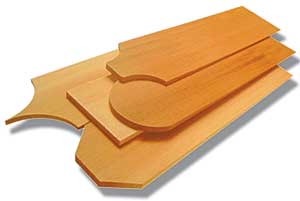Western Red Cedar Shakes and Shingles: A Sustainable, Versatile Roofing Choice
Shakes
Handsplit and resawn shakes are split faced, exposed with a naturally rustic appearance, and sawn on the back. The most common sizes are 18 inch and 24 inch nominal lengths. Butt thicknesses range from 3/8 inch to over 2 inches.
Tapersawn shakes are sawn on both sides for a semi-textured look with a stronger shadow line than shingles. The most common are 18 inch and 24 inch nominal lengths. Butt thicknesses range from 5/8 inch to 1 1/2 inch.
 |
Courtesy of Cedar Shake and Shingle Bureau |
Shingles
Shingles are sawn on both sides for a tailored appearance. They are available in several sizes: 16 inches or Fivex; 18 inches or Perfection; and 24 inches or Royal nominal lengths. The butt thickness is gauged using a stack of shingles to meet the proper measurement. Rebutted and rejointed (R&R) sidewall shingles are remanufactured on all four sides to ensure square butts and parallel edges for a superior appearance. Faces can be also obtained in sanded or machine profiles. Fancy butt shingles are available in a variety of designs and are useful in creating a variety of sidewall pattern designs.
 |
Courtesy of Cedar Shake and Shingle Bureau |
Prefinished Rebutted and Rejointed Sidewall Shingles
Prefinished sidewall shingles make a wise, low maintenance sidewall system. Specifying prefinished shingles depends upon project needs. Three basic types of prefinish systems are available: preprimed, prestained, and opaque. Coatings and finishes are classified as film forming or penetrating. Paint and solid body stains are film forming. Penetrating stains penetrate wood. Latex stains are classified as film forming although some formulations are showing better penetration characteristics. Latex stains are evolving.
Custom colors as well as product and coating manufacturers' warranties are available.
- Preprimed: Kiln dried, rebutted and rejointed shingles should be coated on all surfaces with an alkyd oil, stain blocking primer at the manufacturer's recommended spread rates. Latex stain blocking primers are evolving.
- Prestained: Penetrating stains have been traditionally oil or alkyd oil-based. New latex formulations are being developed which show better penetration characteristics than older latex formulations. Pre-staining coats the shingle on all surfaces. Penetrating stains are available in clear, lightly pigmented and semi-transparent. Alkyd oil refers to a type of durable synthetic resin or coating.
- Opaque: Opaque color finishes are applied to the shingle after an alkyd oil stain- blocking primer has been applied to all surfaces of the shingle. Two or three coat systems are available. Factory finish equipment generally uses different formulations than over-the-counter solid body stains and paints. The factory finish topcoats are referred to as a finish coat.
If adding a coating at the job site, the base coat should contain a stain-blocking primer. The primer is to be applied to all surfaces of the shingle after the shingle has achieved equilibrium (12-14 percent and less moisture content in most of North America). Applying a coating on wood which is green (above the equilibrium point) will result in premature coating failure.
All forest products, including Western Red Cedar, contain extractives (tannins). Extractives are either water borne or solvent borne. Western Red Cedar contains water borne extractives. Extractive bleeding (stains) on the surface of Western Red Cedar occurs when extractives are dissolved and leached from the Western Red Cedar by water. The water then moves to the finished/coated surface, evaporates and leaves the extractive discoloration which may be dark red or reddish-brown in appearance. Extractive bleeding is easily prevented when the proper primer and topcoats are applied using the coating manufacturer's recommended spread rates, time of application (i.e., not too cold/hot or in direct sunlight). Environment and moisture content level should be considered during the proper application phase.
Wood should not be left to weather prior to applying a coating; exposure to the weather causes photodegradation of the top layer of the wood. The color changes as a result from the decomposition of extractives at the surface. The sunlight will decompose the lignin (the natural "glue" which holds wood fiber together) leading to a poorer adhesive bond when a film forming coating product is used. Photodegradation is the chemical transformation of a compound into smaller compounds caused by the absorption of ultraviolet, visible, or infrared radiation (light).
Proper preparation of the shingles and application of a good quality coating or finish are key to good coating performance and life.









